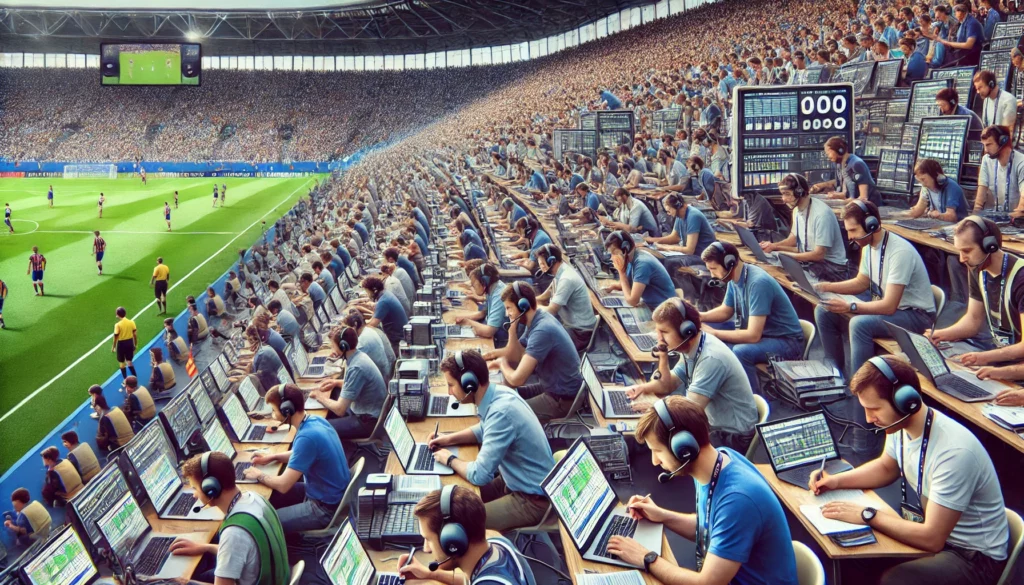
The use of data analytics in football, particularly at major tournaments such as the UEFA European Championship (EURO) and the FIFA World Cup (WC), has evolved dramatically over the years. The history of this development, and in particular the practice of manual tagging, offers fascinating insights into the evolution of sports technologies and strategies. This blog post provides an overview of the history of data usage at football tournaments and highlights the changes that have taken place over the years.

The evolution of data collection and analysis at major football tournaments such as World Cups and European Championships reflects technological advances and the growing importance of data science in sport. Here's a look at the key changes and comparisons between different eras.
In the 1980s, data analysis methods in football were still in their infancy. Most of the data was collected manually and the concept of systematic analysis had barely been developed.
With the advent of the first computer programmes, teams began to use more systematic forms of data collection.
The 2000s brought a major technological leap with the introduction of automated systems and advanced analysis tools.
Introduction of Prozone: This tool enabled more detailed performance analysis through automated tracking systems.
The use of big data and artificial intelligence has further revolutionised data collection and analysis over the last decade.
Current and future developments point to further automation and refinement of data.
The history of data analysis in football shows a clear evolution from manual, paper-based methods to an era of digitalisation, automation and intelligent data management. Each decade has seen innovations that have not only changed the way games are analysed and understood, but have also had a direct impact on improving the performance of teams and players. The future promises to continue this revolution with even smarter and more connected systems that have the potential to transform football in unimaginable ways.

Germany, particularly during the 1974 World Cup on home soil, utilised advanced statistical recording to improve the team's performance. Under the leadership of Helmut Schön and later Franz Beckenbauer, the DFB began to keep more detailed records of match behaviour, including players' running routes and the distribution of passes. These manual analyses helped to develop match strategies aimed at exploiting opponents' weaknesses.
Italy, who won the 1982 World Cup, also relied on traditional methods of data collection to gain deeper insights into their players' performances. The Italian Football Federation used match reports and manual statistics to analyse the fitness and tactical behaviour of its players. This data was used to strengthen the defensive tactic known as "catenaccio", a strategy that relies heavily on solid defence.
Spain's dominance, winning the 2008 European Championship, the 2010 World Cup and the 2012 European Championship, was in part the result of sophisticated data analysis.Spain used data to perfect the famous tiki-taka system of play, based on precise passing, possession and utilisation of space. Analysing player patterns and evaluating opponents' strategies allowed coaches to maximise the effectiveness of their system of play.
The success of the German national team at the 2014 World Cup in Brazil is a prime example of the effective use of data analytics, with the German Football Association (DFB) working closely with SAP to develop a special analytics tool that could be used to analyse player performance in detail and develop optimal match tactics, helping the German team to better analyse their opponents and adapt their own game strategy. The convincing victory against Brazil in the semi-final and the triumph against Argentina in the final showed how data analysis can help to optimise performance and tactics.

Major football organisations such as FIFA and UEFA recognised the potential of data analysis early on and invested in personnel accordingly. At major tournaments such as the World Cup and European Championships, more than 100 people were often employed per match to collect and record all relevant data.
These teams of data analysts and statisticians were tasked with tracking every action on the pitch and manually entering it into specialised systems.
Major football organisations such as FIFA and UEFA recognised the potential of data analysis early on and invested in personnel accordingly. At major tournaments such as the World Cup and European Championships, more than 100 people were often employed per match to collect and record all relevant data.
These teams of data analysts and statisticians were tasked with tracking every action on the pitch and manually entering it into specialised systems.
At major football tournaments, FIFA and UEFA utilised impressive logistics to ensure the quality and quantity of data collected.
Each team of analysts was responsible for specific aspects such as player actions (shots, passes, tackles), match events (goals, cards, substitutions) and positions on the pitch.
Manual tagging, especially in an environment as dynamic and fast-paced as a football match, presents significant challenges:
Today, data analysis and tagging in football is highly technical and automated. The use of AI and machine learning makes it possible to recognise complex patterns and strategies that human observers may miss. Recent tournaments, such as the 2020 European Championship and the 2022 World Cup, have utilised advanced tracking systems and analytics tools to provide detailed insights into almost every aspect of the game.

The history of data collection and tagging in football clearly shows how technological advancements have changed the way we understand and analyse games. From the days of manual tagging to modern real-time analysis, data science has had a profound impact on football. While major tournaments such as the European Championship and the World Cup continue to serve as a stage for the latest innovations, it remains exciting to see what developments the future will bring.